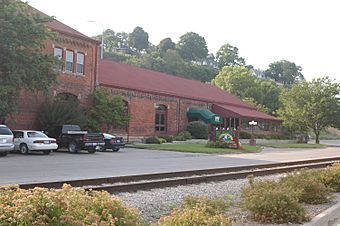- This page was last modified on 17 October 2025, at 10:18. Suggest an edit.
Burlington, Cedar Rapids & Northern Freight House facts for kids
|
Burlington, Cedar Rapids & Northern Freight House
|
|
 |
|
| Location | Front and High Sts. Burlington, Iowa |
|---|---|
| Area | less than one acre |
| Built | 1898 |
| NRHP reference No. | 83000351 |
| Added to NRHP | January 27, 1983 |
The Burlington, Cedar Rapids & Northern Freight House, also known as the Rock Island Freight House, is a historic building in Burlington, Iowa, United States. It was added to the National Register of Historic Places in 1983 because of its important history.
Contents
A Historic Railroad Building
This building was once a busy place where goods were moved between trains, wagons, and even riverboats. It played a big role in how products traveled across the country.
Building a Freight House
The freight house was built in 1898 by the Burlington, Cedar Rapids and Northern Railroad (BCR&N). It replaced an older, smaller brick building from 1873. This freight house is special because it's the only building left in Burlington from the BCR&N railroad. It's also the only Victorian style building still standing along the riverfront.
A Hub for Goods
The BCR&N railroad was very important. It had train services for both people and goods between Minneapolis and St. Louis. Many people thought it was the most important north-south train line in Iowa.
In 1903, another big railroad, the Chicago, Rock Island and Pacific Railroad, bought the BCR&N. So, the freight house then served the Rock Island Line.
New Uses for an Old Building
After the Rock Island Line stopped operating, the freight house sat empty for a while. Later, it was turned into a restaurant, giving it a new life. The building has faced challenges, like big floods in 1993 and 2008, which caused damage. Each time, it had to be repaired and restored.
What the Building Looks Like
The freight house is made of brick and has two main floors. On its north side, there's a smaller, single-story part.
How Freight Moved
The building was designed to make moving goods easy. On the east side, there were seven large openings where freight was loaded directly onto trains or unloaded from them. On the west side, there were another seven openings. These were used for wagons and, later, trucks to pick up or drop off goods. The building was also used to transfer freight from riverboats on the Mississippi River onto trains.


